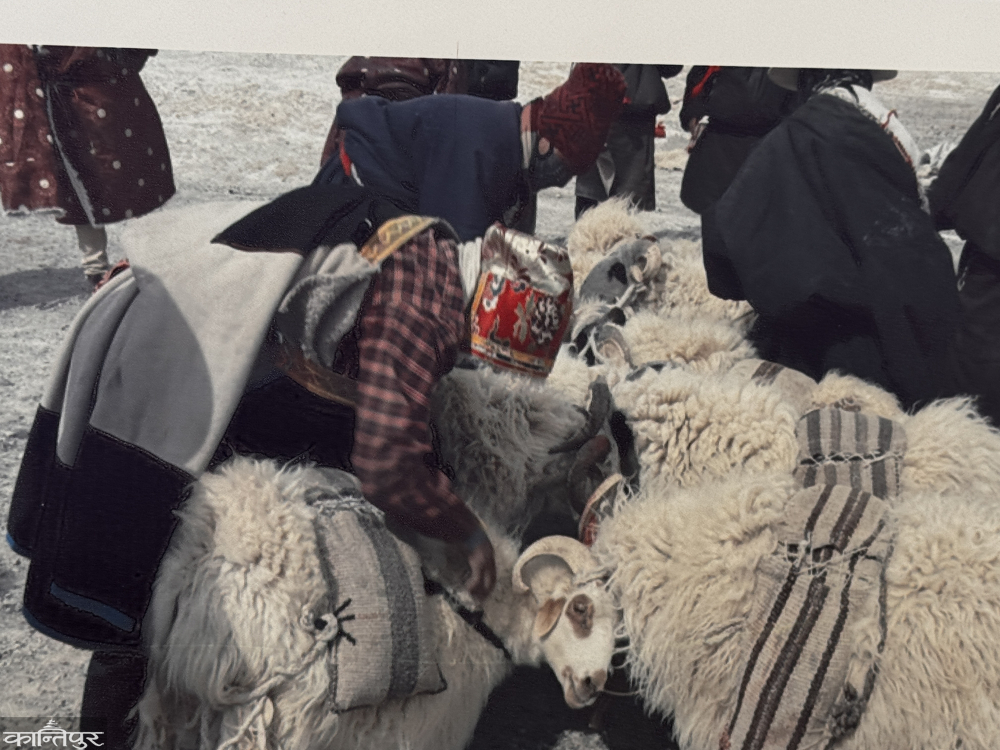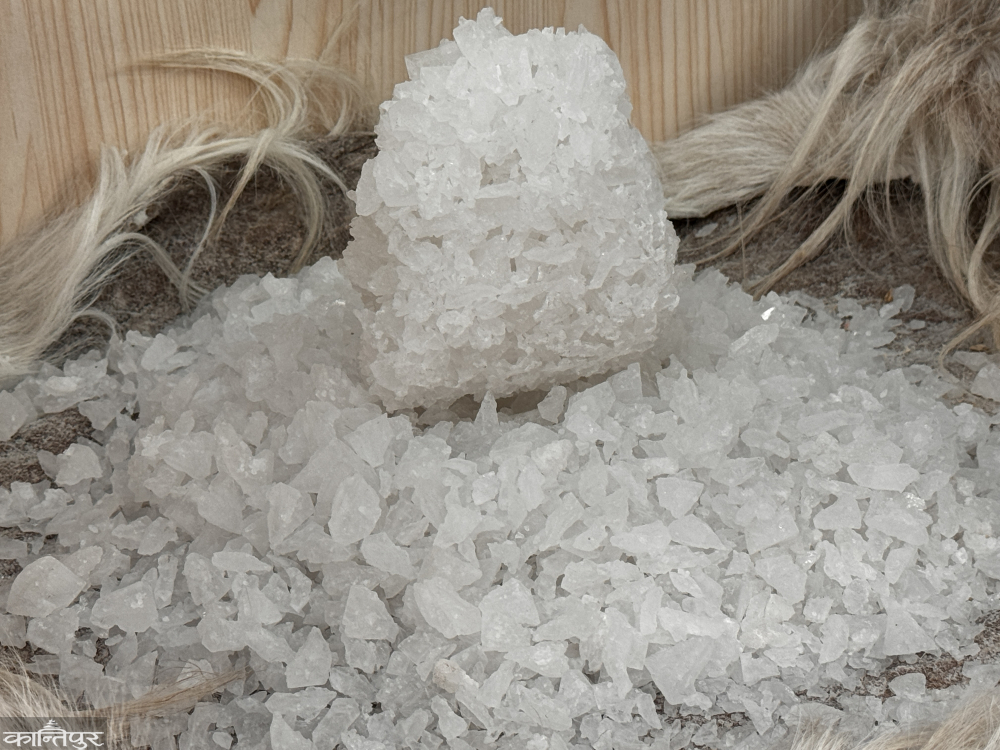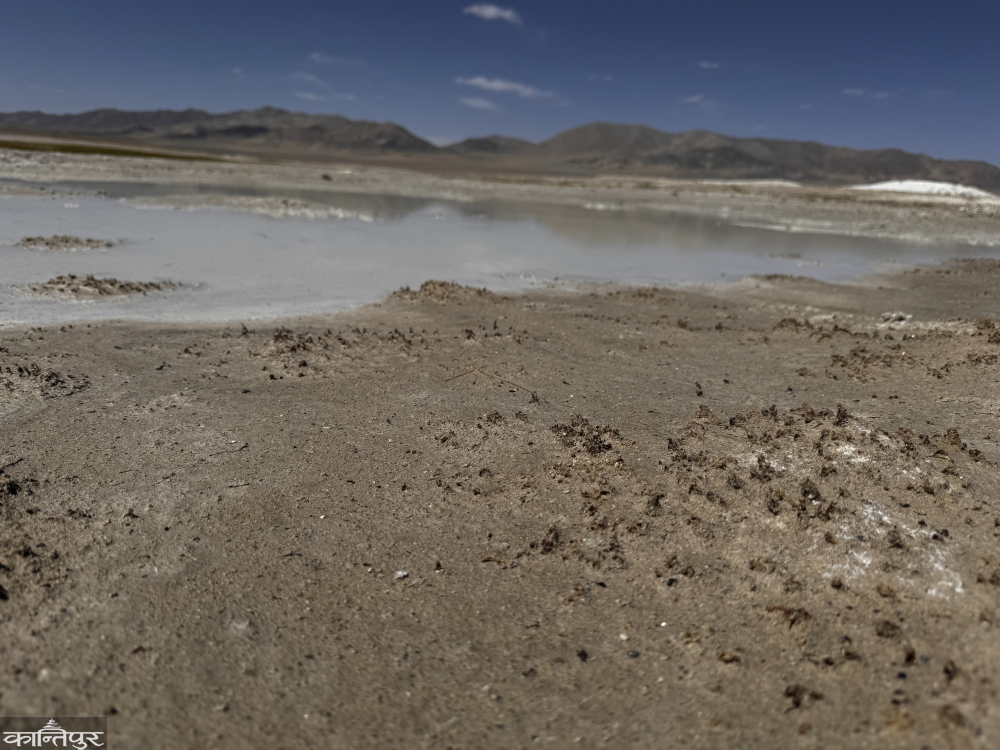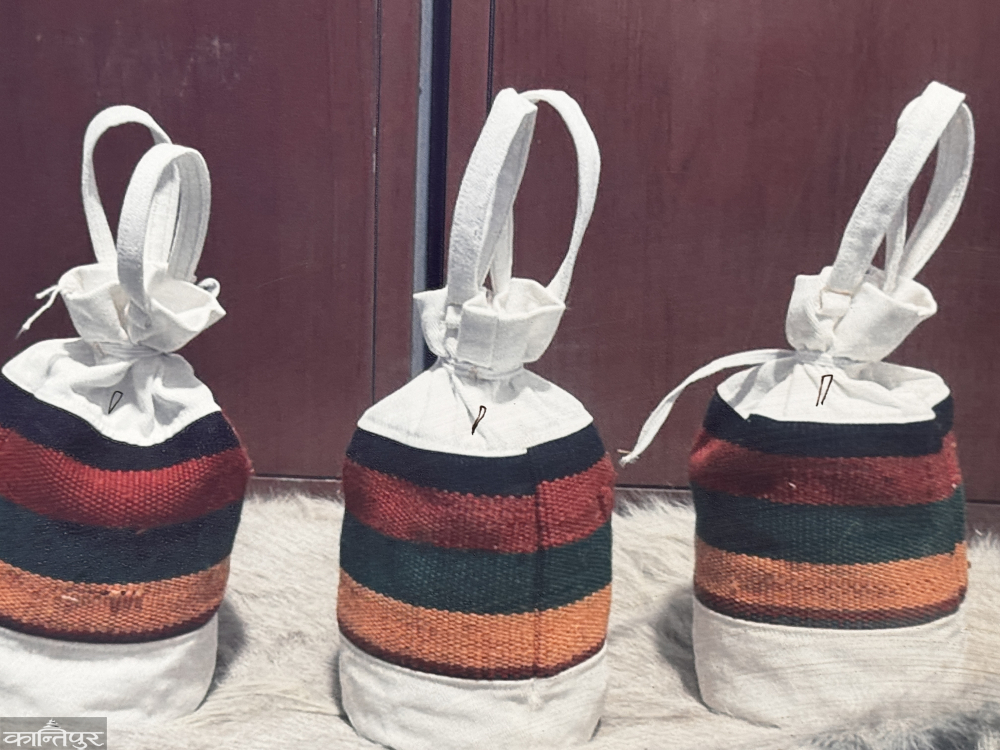Bhot-Nepal Old Encounter on Salt-Sheep Route

We use Google Cloud Translation Services. Google requires we provide the following disclaimer relating to use of this service:
This service may contain translations powered by Google. Google disclaims all warranties related to the translations, expressed or implied, including any warranties of accuracy, reliability, and any implied warranties of merchantability, fitness for a particular purpose, and noninfringement.

Highlights
- Because of the salt trade, common Nepalese know the Bhot area, but different places within Tibet have different names. One name is Ka Chi district which was connected with Nepal almost 1000 years ago. The salt here is exported to Nepal.



An old photograph of a salt merchant was hung to cover the wall in a factory in the county of Ka Chi in Tibetan Ali Prefecture. Since it is the origin of Tibetan salt, a team of journalists from Beijing arrived there in mid-August with filming programs.

The picture brought back my childhood memories. Carrying radipakhis, carrying bags made of sheep wool, with disheveled hair and ethnic faces of the Himalayas, it gave the 'organic' taste of Bhote carrying goods around Nepal. After asking a person standing there where they would be, he said, "The people in the back are staying at home now, but the two in front are two/three years ago...!
When my eyes turned to look for the meaning of the silence while looking at the picture, they were half biting their tongue. When you look at it, it looks very Nepali. Perhaps it is the effect of Nepal's border? 
People who speak Chinese can easily be found in the vast plateau of Tibet. Children take Mandarin classes from a young age. If China seems to understand one thing, one of the ways to bind the country to the formula of unity is to establish communication between citizens through the same language. He spoke Mandarin well and also English. Tourist for 10 years Having worked as a guide, he is fluent in English. Now that he is away from English after separating from this profession, he preferred to stay by my side as he had the opportunity to introduce English in this way.
...
Common Nepalese know the Bhot area because of the salt trade, but different places have different names within Tibet. One name is Ka Chi district, which has been connected with Nepal since almost 1000 years ago. Salt here is exported to Nepal in history.
At that time, Nepal and Tibet were in the grip of poverty. In other words, there was no development of technology and roads. The reliable transportation of salt was sheep. Salt bags were sewn from wool and loads of salt were transported by sheep.
was written in Chinese as 'Yanyang Ancient Road' with 'Yan' meaning salt and 'Yang' meaning sheep.
 Tibet has naturally rich natural salt lakes, but because it is cold and lake-like, it was not easy to mine the salt found here. Salt not only fulfilled the daily needs of people but also exported flavor to Nepal, India or other regions. Salt was transported to places like Burang, Sigatse, India and Nepal, taking 2 to 3 months and facing hundreds of difficulties.
Tibet has naturally rich natural salt lakes, but because it is cold and lake-like, it was not easy to mine the salt found here. Salt not only fulfilled the daily needs of people but also exported flavor to Nepal, India or other regions. Salt was transported to places like Burang, Sigatse, India and Nepal, taking 2 to 3 months and facing hundreds of difficulties.
The main subject of trade exchange was salt along with barley, tea, cloth and other food items . It was also a wisdom of the time to name the Salt Sheep Ancient Way in recognition of the interdependent relationship between salt and sheep. At that time, the rich man was said to be the one who had the sheep that transported the most salt . Usually, having 1000 sheep was like a demonstration of power.
...
The purpose of the media team from Beijing was to follow the modernization of the salt industry there. The traditional method of salt mining remains the same but modern equipment has been invented in the processing method. In addition to edible salt, industrial salt, massage salt, the variety of salt is constantly being developed .
 Looking at the state-of-the-art equipment, our desire to see how the salt will be processed turned out to be electricity. By the time we reached there, 'Thing Tien' ie load shedding was going on . Even from here there are glimpses of Nepal. Nepalis are not unfamiliar with load shedding. Where there is a shortage, there is a possibility that Nepal is trying to export electricity.
Looking at the state-of-the-art equipment, our desire to see how the salt will be processed turned out to be electricity. By the time we reached there, 'Thing Tien' ie load shedding was going on . Even from here there are glimpses of Nepal. Nepalis are not unfamiliar with load shedding. Where there is a shortage, there is a possibility that Nepal is trying to export electricity.
Since 2005, Chiang Mai Salt Factory has been established and in 2014, salt has received a trademark. In 2018, the local government identified the coarse salt processing plant as a poverty alleviation industry project and invested in upgrading the processing plant. It has a heated dryer, a crusher, a belt conveyor and two packaging machines .
Moto salt processing plant has developed into a complete industry chain enterprise integrating salt collection, storage, processing, packaging and sales, Chinese media write . Although the trade with Nepal has been limited in history, the salt processing factory seems to be upgrading it more and more. Ali Prefecture, Ka Chi County, Cha Kha Village Party Committee Secretary Kongchoe Tshiring, expanding the sales channels of salt and expanding the brand is still accelerating. He said, 'Our salt has a history and culture. Our salt factory is still developing, it has inspired the locals to become rich.' In addition to inventing
production equipment, the factory provided local people with Income is given. In the months of July and August every year, local people are employed in making salt . Manpower is needed to absorb salt from the lake and undergo various processes of salt processing.
A police car was stopped in the factory premises while looking at the device that was idling due to the power cut . We had to climb it. I said, 'Ah police car! But I'm not afraid.' When I spoke in Chinese, the other people present in the factory yard laughed . A ravenous monster dragged 2 of us cameramen on a dickie and drove 6 of us towards the salt lake.
So far, the current generation does not have an answer to the question of where salt comes from. It can be obtained from a shop or sahuji, or if not, it comes from the sea . While looking for nationalist leaders who understand the country and the people, some people are heard sarcastically saying, "First, a salt factory should be opened in the country". Would you have found a leader who would benefit this soil and people just by eating the salt of your country?'
But where to get salt in a landlocked country with no sea? It was surprising to see the sight of salt even in a lake without sea for the first time.
...
Looking at the vast surroundings as far as the eye could see, we approached the white lake that spread far and wide at the foot of the mountain . At other times only a blue lake was seen in Tibet, but this time a white or purple lake was seen. In Bichh-Bichh, there are some pieces of water that seem to be screaming towards the sky . "Yes, this is salt," said the driver, scraping off the white parts piled up on the shore. From here, put in bags and sacks and take them to the factory and process them.'
 Back to the factory again, the car dropped us off . The drivers are especially security personnel. A 'Salt Special Factory Site' is where only the employees live and do related work . An official responsible for salt technology appeared in front.
Back to the factory again, the car dropped us off . The drivers are especially security personnel. A 'Salt Special Factory Site' is where only the employees live and do related work . An official responsible for salt technology appeared in front.
'Nowadays, where does the salt go in Nepal, do the Nepalese eat the salt of the vote? ' He said, 'Pu Ch Tao' (I don't know.)
was not the subject of further discussion after that . It has been many years since the Salt Silk Road was built. Currently, Chinese salt hardly goes to Nepal, but salt is imported from India or other countries.
If this process of salt export had not been stopped, two things would have definitely remained alive, firstly, the legacy of friendship with China would have been stronger, secondly, Nepal's food productivity would have been maintained.
In history, there were fluctuations between Nepal and Bhot due to salt. But at that time, Nepal was still dependent on Tibet for salt, although the dependence has 'shifted'. Nepal would eventually try to maintain the friendship by compromising. Another thing is that if this exchange was maintained, the productivity of Nepal's agricultural sector would have been increasing even for export. Currently, Nepal has come to a position of having to import minimum crops and food grains.
Surely the roads and technology would have facilitated the volume of business commerce .
 time has changed . Science and technology have made life easier. The nature of business has changed. Now the Plateau does not have to turn to Nepal or any neighbor for food. Due to prosperity, life is gradually getting easier .
time has changed . Science and technology have made life easier. The nature of business has changed. Now the Plateau does not have to turn to Nepal or any neighbor for food. Due to prosperity, life is gradually getting easier .
Nepal has not stopped the production of salt even though it has lost its trade with Tibetan salt . While searching for many dimensions in poverty alleviation, China is still excavating, modifying and strengthening the ancient heritage. Although Tibet does not export salt, it has adopted a system of consumption throughout Tibet. Salt is not only added to vegetables, it is being consumed in work such as massage medicine, pet nutrition, increasing diversity .
The responsible official, who did not know where the Nepalese eat salt, offered to take a photo as a reminder when we return. The factory staff were eager to see off our vehicle. While looking at the photos taken on her mobile phone, I teased, so what am I less than you? I'm about to find the fleas, can't you make salt to reduce fleas?'
laughter echoed . The car is done .
 प्रकाशित : भाद्र २, २०८१ १६:१९
प्रकाशित : भाद्र २, २०८१ १६:१९

 २२.१२°C काठमाडौं
२२.१२°C काठमाडौं














